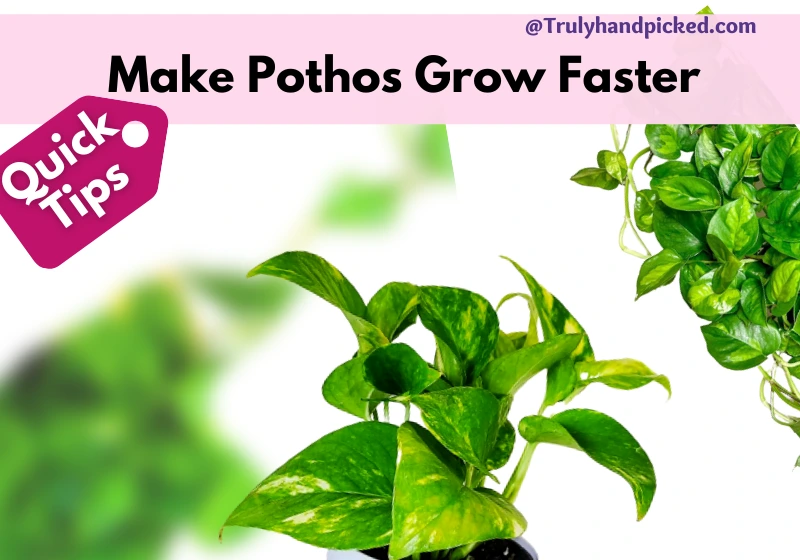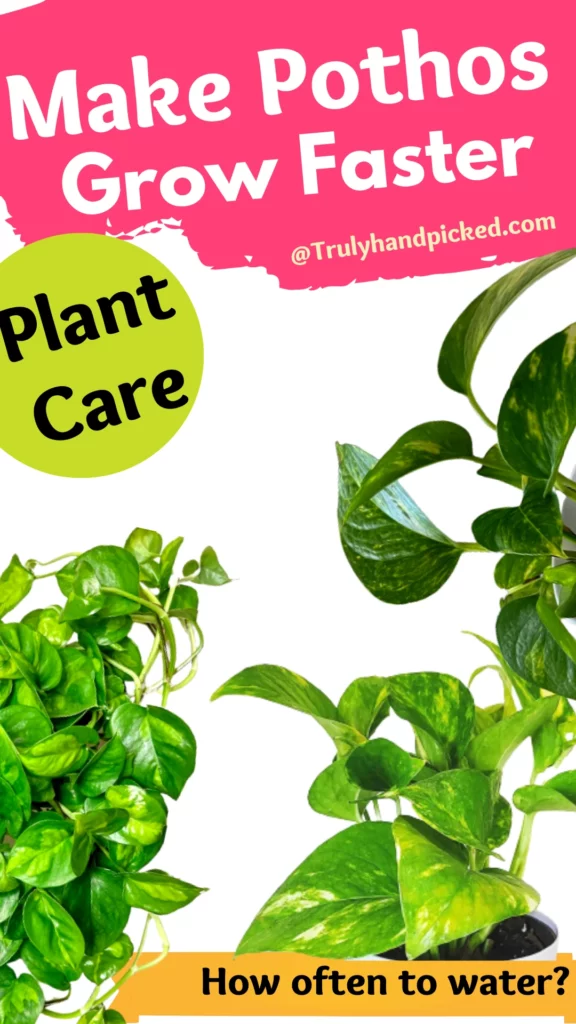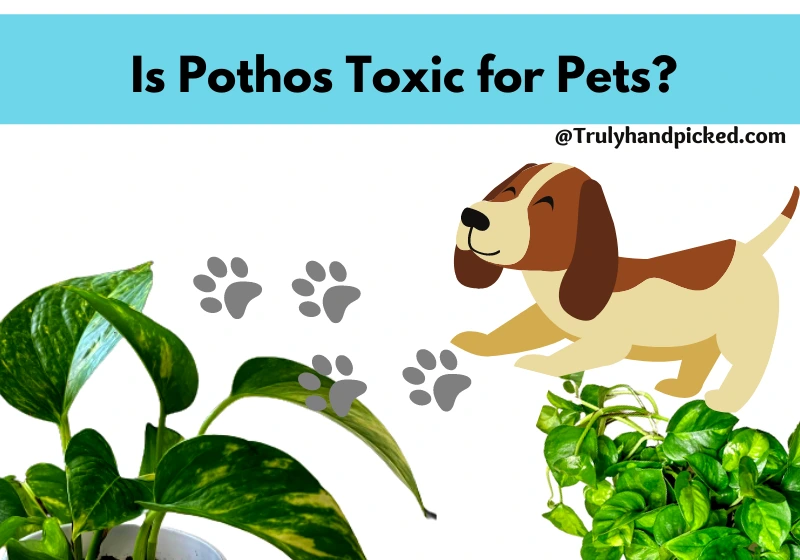Pothos plant is a typical houseplant that is easy to care for with some basic plantation methods. This species of the Araceae family is native to southern Asia. It pauses a tropical appearance when added to a room.
Make your pothos grow faster: Healthy loamy rich growing medium which drains well and is not soggy. Watering twice a week after the soil surface turns dry.
Feeding once every 3 months without overwatering and bright indirect sunlight for the whole day is the perfect recipe to make your plant grow faster and remain lush green.
This plant has plenty of other names, besides pothos, like money plant, devil’s ivy, golden pothos, etc. Despite being a toxic houseplant, pothos is one of the most popular options that utmost indoor gardeners pick to cultivate.
Here are some must-know facts about pothos that will help you to grow this beautiful houseplant more smoothly than ever-
Pothos Plant Care: Overview
Soil: Slightly acidic and Mildly loose yet slightly clay-based soil with well-drainage quality.
Water: Moderate water needs like once every week during the summer or for the other normal weather
Sun Exposer: Sun with partial shade
Fertilizer: Any balanced liquid fertilizer with the perfect ratio of nitrogen, phosphorus, and potassium.
Hardiness Zones: 10 to 12
Why my pothos is alive but not growing?
Lack of nutrients in the growing medium, low light for the whole day, and less watering and humidity stress can hinder your plant’s growth. Also, check for pests and root rot to prevent further damage to your plant.
How to Care for Pothos:
Now, let’s look at the proper caring process of pothos to give the best thriving climate most effortlessly-
Soil and Potting Mix:
Be very particular about the soil and potting mix to sow a pothos plant. Once you made the plantation medium perfect, there would be no chance of failure to get a thriving pothos plant in the house soon.
Choose a soil type that is perfectly balanced between loamy and rich soil. Your soil must retain the water for a while but never be soggy ever.
Use peat moss, perlite, and pine bark along with potting soil in a 2:1:1 ratio. Keep the pH level between 6.0 to 6.5 for the best result.
When and How Often to Water:
Water your plant thoroughly once after the plantation. After that try watering twice every 7-10 days. You can even wait till the top surface of the soil turn dry completely, from one watering session to another.
Use mulch to retain the water for a little more time effortlessly and apply organic mulching alternatives for the best outcome of your effort.
Feed/Fertilization Need:
Pothos planta is not a high feeder and they even survive without any fertilization at all! Try to make the potting soil fertile enough during the planation and you don’t need to feed to plant often then.
To provide any additional nutrients to a thriving pothos plant, apply any balanced liquid fertilizer in a 10-10-10 NPK ratio.
Needed Climate:
To give your plant the best thrives, provide indirect bright light throughout the day. Maintain the temperature between 60 to 85 degrees F, and never let it down more than 50 degrees F.
This species of arum family can stand low humidity but, it is always better to keep them in high humidity to avoid having any troubleshoots to your favorite houseplant.
Process of Pruning:
Pothos plants grow bushier, so, try to prune them in time, before the unhealthy parts start bothering the fresh sections. Bring a finely washed scissor or shear and make an apparent cut near the base of the bushier stem.
Find out the big, brown, or yellowish leaves also during this process and trim them off. But Prune long and leggy stems can help to start new shoots. It suits for few of us who love bushier pothos on a hanging basket.
Process of Repotting:
Pothos plants grow through both sides from length to width. It can reach the height of 10 feet in trail form while the foliage can spread 3 feet long.
So, you should report it once in a year, after it starts overgrowing the present pot. To repot the plant, follow the steps below-
- Bring a 3-4 inch bigger pot than the current planter and wash and disinfect the bottom properly
- Now, pour a prepared mixture of soil-potting mix-fertilizer and dap the center part with your hand a little
- Take the whole pothos plant out of its current pot and trim the root a bit
- Clear the tight soil holds and place it into the hole of the soil-potting mix carefully
- Secure the base with some more potting mixed soil, and water it thoroughly.
How to Propagate
It is effortless to grow a pothos plant from its cutting with some basic propagating rules. Let’s check them out below-
- Find a healthy stem with 3-4 juvenile to mature leaves first
- Now, cut 4-6 inches stem out with a sharp object below the root nod and place it in a pot full of distilled water
- Let the cutting this way until it grows larger and roots come out from the bottom
- Then, sow it in a planter prepared with potting mix and provide an adequate growing climate to let the plant thrive perfectly.
Difference Between Pothos and Philodendron:
Pothos and philodendrons both are vining plants. They both grow similar-type in foliage and both can thrive easily in indoor climates. Thus, sometimes, philodendron and pothos get deceived as to the same plant by some novice gardeners. But there are a few clear differences that exist between these beautiful houseplants, they are-
- Despite having similar shapes, pothos foliage is totally green, while philodendron leaves can get a coppery or purplish hue over the green shade
- Pothos plants need indirect but bright light with consistent temperature to grow, while philodendrons can tolerate low light with different ranges of temperature
- Leaves of pothos form unfurl while fully grown, while philodendron foliage turns opaque sheath with a waxy layer when totally matured
- Pothos grows leaves in a light green shade, while philodendron grows leaves in a deep green shade
- And pothos’s ariel roots are more stubby than the ariel roots of philodendron plants.
Reasons for Your Pothos Leaves Turning Yellow?
Sometimes, you may find that the leaves of your favorite pothos plant suddenly turn yellow without leaving any clue! There are some reasons that always work behind this common troubleshoot of an unhealthy pothos plant, and they are like-
- When you overwater your indoor pothos plant,
- If you water your plant rarely and couldn’t fulfill the water requirements perfectly
- When your plant couldn’t get enough nutrients to thrive
- And when you can’t provide a proper climate or satisfactory amount of sunlight to your growing pothos plant
Whenever the soil of a growing pothos plant, gets improper moisture, inadequate nutrients, and unsuitable climate than its actual requirements; you will face this problem for sure. Some inevitable troubleshoots a pothos plant gets due to this issue, are-
- Root rot
- Bacterial build-ups
- Fungal infestation in the soil
- Pests’ infestation of the sap and stems, including foliage
- And nutrient deficiency
All of these problems lead your plant towards this condition when the leaves of a pothos plant turn yellow gradually. In such matters, try to recheck the availability of the essential needs of your plant carefully and try to accomplish them accordingly.
FAQ:
Is Pothos Toxic to Dogs?
Pothos plants are toxic to any house pet including dogs. Don’t let your dog stay around a pothos plant for long or touch or ingest its foliage ever to avoid any kind of mishaps in the near future.
Though pothos/devil’s ivy leaves are not fatal or deadly, it is the insoluble calcium oxalate crystals that make them dangerous for pets.


